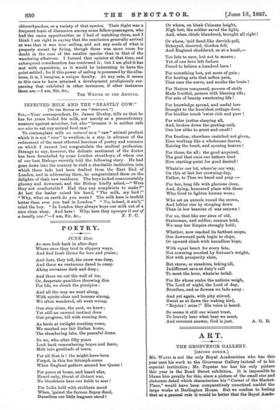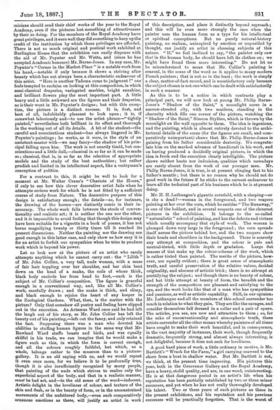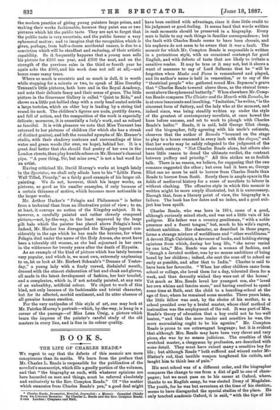ART.
THE GROSVENOR GALLERY.
[SECOND NOTICE.]
MR. WATTS is not the only Royal Academician who has this year sent his work to the Grosvenor Gallery instead of to his especial institution ; Mr. Poynter too has his only picture this year in the Bond Street exhibition. It is impossible to blame him greatly for this, since a picture of the small size and elaborate detail which characterises his "Corner of the Market. Place," would have been comparatively unnoticed amidst the large works at Burlington House. But we confess to feeling that as a general rule it would be better that the Royal Made-
miciana should send their chief works of the year to the Royal Academy, even if the pictures lost something of attractiveness by their so doing. For the members of the Royal Academy have great privileges, and it were well they did something to keep up the credit of the institution by which those privileges are afforded. There is not so much original and poetical work exhibited at Burlington House that the exhibition can easily dispense with the aid of Mr. Poynter and Mr. Watts, and (since he has accepted Academic honours) Mr. Borne-Jones. In any case, Mr. Poynter's "Corner in the Market-Place" is a notable work from his hand,—notable if only because it shows a striving after beauty which has not always been a characteristic endeavour of this artist. 'Here is another Tadema come to judgment I" one feels tempted to exclaim on looking at this composition, in which semi-classical draperies, variegated marbles, bright sunshine, and brilliant flowers play the most important part. A little heavy and a little awkward are the figures and their draperies, as is their wont in Mr. Poynter'a designs ; but with this excep- tion, the picture is a distinct success. It is, first, and best of all, indubitably pleasant to look upon ; it is, if somewhat laboriously and—to use the artist phrase—" tightly painted," nevertheless both brilliant in its effect and thorough in the working out of all its details. A bit of the student—the -careful and conscientious strident—has always lingered in Mr. Poynter's paintings ; he works, as it were, in the style of an -assistant-master with—we may fancy—the shadow of his prin- cipal falling upon him. The work is not exactly timid, but con- scientious and a little dull,—classical in so far as it can be made so ; classical, that is, in so far as the selection of appropriate models and the study of the best authorities ; but rather prudish and limited in its intellectual aspect, like a vestryman's conception of polities.
For a contrast to this, it might be well to look for a moment at Mr. Walter Crane's "Chariots of the Hours," if only to see how this clever decorative artist fails when he attempts serious work for which he is not fitted by a sufficient course of study from Nature. The decorative purpose of this design is satisfactory enough ; the details—as, for instance, the drawing of the horses—are distinctly comic in their in- accuracy. The whole work falls between the stools of conven- tionality and realistic art ; it is neither the one nor the other, and it is impossible to avoid feeling that though this design may have been suitable for a vignette in a book of poems, it has not borne magnifying twenty or thirty times till it reached its present dimensions. Neither the painting nor the drawing are good enough in this latter case, and only show us how easy it is -for an artist to forfeit our sympathies when he tries to produce work which is beyond his power.
Let us look now at the picture of an artist who rarely attempts anything which he cannot carry out : the " Lilith " -of Mr. John Collier, a very tall, nude woman, with a mass of fair hair toppling over her shoulder, and her chin bent down on the head of a snake, the coils of whose thick, black body encircle her from head to foot,—such is the subject of Mr. Collier's composition. The figure is graceful enough in a conventional way, and, like all Mr. Collier's work, carefully drawn ; and the snake is thick, and slimy, and black enough to rejoice the heart of any keeper in the Zoological Gardens. What, then, is the matter with the picture? Only that somehow all poetry and feeling have slipped out in the execution. As Artemus Ward once said he had left the laugh out of his story, so Mr. John Collier has left the beauty out of his painting,—left out the fancy, and only retained the fact. Supposing there was a man who devoted his -abilities to stuffing human figures in the same way that Mr. Rowland Ward stuffs beasts and birds, and was equally skilful in his trade, we can imagine that he would make a figure such as this, in which the form is correct enough, -and all the colours roughly faithful, but which, as a whole, belongs rather to the museum than to a picture- gallery. It is an old saying with us, and we would repeat it even once more, for we believe it to be profoundly true, though it is also insufficiently recognised by many people, that painting of the nude which strives to realise only the superficial aspect of the body, and that in a realistic manner, must be bad art, and—in the old sense of the word—indecent. Artistic delight in the loveliness of colour, and texture of the skin and flesh, or in the beauty of form, or in the unconstrained movements of the unfettered body,—even such comparatively sensuous emotions as these, will justify an artist in work
of this description, and place it distinctly beyond reproach ; and this will be even more strongly the case when the painter uses the human form as a type for his intellectual or spiritual conceptions. But no purely natural-history painting, no realism, uninspired by emotion or unpurified by thought, can justify an artist in choosing subjects of this nature. "If," we feel inclined to say, "the painter only saw that in the human body, he should have left its clothes on ; we might have found them more interesting." Do not let 1113 be misunderstood to mean that Mr. Collier's painting is sensual, in the sense of the word as it applies to many modem French painters ; that is not so in the least ; the work is simply a clear, matter-of-fact record, and is unsatisfactory only because the subject chosen is not one which can be dealt with satisfactorily in such a manner.
As this is to be a notice in which contrasts play a principal part, we will now look at young Mr. Philip Burns. Jones's "Shadow of the Saint," a moonlight scene in a narrowetreeted city, with two maidens, standing in the obscurity which fills one corner of the picture, watching the "Shadow of the Saint," Simeon Stylites, which is thrown by the moonlight on the wall opposite to them. The idea is ingenious, and the painting, which is almost entirely devoted to the archi- tectural details of the scene (for the figures are small, and com- paratively unimportant) shows that Mr. Philip Burne-Jones is gaining from his father considerable dexterity. We congratu- late him on the marked advance of handicraft in his work, and on having produced a decidedly original picture, in which the idea is fresh and the execution clearly intelligible. The picture shows neither haste nor indecision, qualities which nowadays are rarely absent from the work of our younger men. Mr. Philip Borne-Jones, it is true, is at present clinging fast to his father's mantle ; but there is no reason why he should not do good work in the future if he sticks to the earnest endeavour to learn all the technical part of his business which he is at present doing.
Mr. H. H. Lathangue's gigantic cornfield, with a sleeping—or is she a dead ?—woman in the foreground, and two reapers pointing at her over the corn, which he entitles "The Runaway," is one of the boldest, and in several respects one of the cleverest
pictures in the exhibition. It belongs to the so.called "naturalistic" school of painting, and has the defects and virtues which usually accompany that style of work. The woman is plumped down very large in the foreground ; the corn spreads itself across the picture behind her, and the two reapers show their heads and shoulders in the background. There is scarcely any attempt at composition, and the colour is pale and neutral-tinted, with little depth or gradation. Large flat masses of tint make up the colour-scheme of the work, which is rather tinted than painted. The merits of the picture, how- ever, are equally evident ; there is great sense of atmospheric truth, and careful preservation of the relative values, decided originality, and absence of artistic trick ; there is no attempt at prettifying the subject ; and though there is no beauty of colour, and but little attempt at beauty of form, the breadth and the strength of the composition are pleasant and satisfying to the eye, and the work looks like that of a man who has sympathies and passions, as well as artistic capability. Still, in our opinion, Mr. Lathangue and all the members of this school surrender too much in relation to what they gain. They are like the savages, and. consider themselves full dressed in a collar and a pair of spurs. The articles, you see, are new and attractive to them ; so, for the sake of unconventionality and atmospheric truth, these artists surrender all the other means whereby painters of all times have sought to make their work beautiful, and in consequence, in the vast majority of instances, their work, though frequently dramatic, frequently strong, and almost always interesting, is not delightful, because it does not seek for loveliness.
A good hard piece of work, a little ordinary in motive, is Mr. Bartlett's "Wrack for the Farm," a girl carrying seaweed to the shore from a boat in shallow water. But Mr. Bartlett is not, we think, at the present time improving. His pictures this year, both in the Grosvenor Gallery and the Royal Academy, have a heavy, stolid quality, and are, in one word, uninteresting. He is at that dangerous period in an artist's life when his reputation has been partially established by two or three minor successes, and yet when he has not really thoroughly developed his talent. Two or three years of such pictures as these in the present exhibitions, and his reputation and his previous successes will be practically forgotten. That is the word of the modern practice of giving young painters large prices, and -making their works fashionable, because they paint one or two -pictures which hit the public taste. They are apt to forget that the public taste is very uncertain, and the public favour a very ephemeral matter; and to imagine that the recognition which is given, perhaps, from half-a-dozen accidental causes, is due to a conviction which will be steadfast and enduring, of their artistic capability. So it frequently happens that a young man sells his picture for £200 one year, and 2300 the next, and on the strength of the previous sales in the third or fourth year he again asks the 2300, and his work does not sell at all,—and hence come many tears.
Where so much is eccentric and so much is dull, it is worth while stopping for a minute or two, to speak of Miss Dorothy Tennant's little pictures, both here and in the Royal Academy, and note their delicate fancy and their sense of grace. The little picture in the Grosvenor Gallery is called " Quiet to Ride," and shows us a little pot-bellied chap with a curly head seated astride a large tortoise, which an older boy is leading by a string tied round its neck. The children's figures are nude, prettily drawn, and fall of action, and the composition of the work is especially delicate; moreover, it is essentially a lady's work, and as refined as fanciful. It is with pleasure we note that Mies Tennant has returned to her pictures of children (for which she has a streak of distinct genius), and left the rounded nymphs of Mr. Henner's studio, with their shadowy contours and surroundings of blue water and green woods (for ever, we hope), behind her. It is a great deal better that she should find poetry of her own in the London streets, than play humble echoes on Mr. Henner's classical pipe. "A poor thing, Sir, but mine own," is not a bad word for an artist.
Having criticised Mr. David Murray's works at length lately in the Spectator, we shall only allude here to his "Little Farm Well Tilled, Picardy," as a fairly good example of his larger oil- painting. We do not, however, think his larger works, as pictures, so good as his smaller examples, if only because of a certain thinness of motive, which becomes more noticeable in the larger works.
Mr. Arthur Hacker's " Pelagia and Philammon" is better from a technical than from an illustrative point of view ; to us, at least, it conveys no notion of the Kingsley subject. It is, however, a carefully painted and rather cleverly composed picture,—not, by-the-way, in the least improved by the large gilt halo which the painter has placed above Pelagia's head. Indeed, Mr. Hacker has disregarded the Kingsley legend con- siderably in the age which he has made the heroine, for when Pelagia died under the name of the Holy Amma, she must have been a tolerably old woman, as she had sojourned in her cave in the wilderness for twenty years after the death of Hypatia.
As an example of the kind of picture which has lately become very popular, and which is, we must own, extremely nupleasing to us, let us look at Mr. Herbert Schmalz's "Dreams of Yester- day," a young lady with a finely curved, disdainful mouth, dressed with the utmost elaboration of hat and cloak and gloves, all made in the latest development of fashion, her hair tousled, and a complexion, which is, if not actually painted, at any rate of an unhealthy, artificial colour. We object to work of this kind, not only because of its fashionable and trivial character, but for its affected, morbid sentiment, and its utter absence of all genuine human emotion.
For the very antipodes of this style of art, one may look at Mr. Fairfax-Murray's portrait—which, by-the-way, is hung in a corner of the passage—of Miss Lena Craig, a picture which bears the impress of the painter's careful study of the old masters in every line, and is fine in its colour quality.




































 Previous page
Previous page